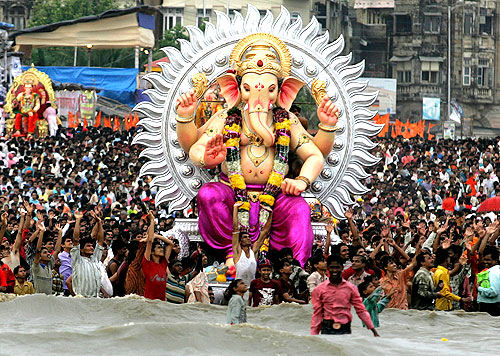India is very rich in terms of variety of festivals. We have festivals almost all seasons, all months, all fraternities and even for all deities. One of them is Ganesha Festival. Ganesh Chaturthi also know as Vināyaka Chaturthi, Gaṇēśa Chaturthī, Vināyaka Chavithi, Chouth, Chavithi, Varasiddhi vinayaka vratam, Pillayar chaturthi, Lambodara pirnalu etc. falls in Bhadarva month as per Gujarati calendar, starting from 4th day of Bhadarva month and lasting for 10 consecutive days. It is believed lord Ganesha’s birthday (પ્રાગટ્ય દિવસ).

The Story & History
This festival has a very famous legend behind it, it is believed that once upon a time, Lord Shiva was in deep trance and goddess Parvati was feeling alone. She then created a child from the debris removed from her body and considered him as her son. While doing so she felt tired and went for a bath. While going for a bath, she instructed that child to guard the main entrance of her edifice and strictly instructed him that whosoever may come, don’t allow anybody to step inside as she would be bathing then.
As instructed, the child stood in front of main entrance; meanwhile lord Shiva was done with his trance and came to see goddess Parvati. There, he encountered a boy at the entrance whom he has never seen before. The boy arrogantly stopped lord Shiva and challenged him to fight with him if he wanted to step in. The angry lord Shiva cut the head of that boy with his deadly weapon – Trishul. As soon as the boy fell down on earth wit cut head, the goddess Parvati came out and started mourning. Here, Lord Shiva became speechless when he came to know that child was his son. He then repented and sent his men in jungle and bring the head of first ever creature they encounter. They returned with head of elephant which was connected to the body of that boy and he was resurrected. When goddess Parvati mourned as a mother that her son is having face of an animal, then Lord Shiva consoled her and blessed that child with tremendous amount of wisdom, intelligence and ingenuity; not only this but also declared that since then he must be worshipped first in any of the rituals whatsoever and for whosoever other deities. So since then we were blessed with new god called – Lord Ganesha who is also known as Ganpati, Ekdant, vakratund, etc 108 names which all descried his various features and legends of his life.
If we see the historical and social significance; this festival was started by the freedom fighter Shri Bal Gangadhar Tilak during old days before freedom. The major purpose was then was to bring people on the common platform and be united to fight against the Britishers. After freedom, Maharashtra state became the hub of this festival majorly and was the best platform of brotherhood, equality and unity. During this festival there used to be so many socio-cultural activities where youth were getting opportunities to perform their talent and shine. It was the centre of people’s faith and trust on god. Devotees used to come and offer god their services and pray to clutch their grief, pain and problems.
Commercialization
With the passage of time, slowly & gradually this festival started becoming commercialized and so many evils entered into entire system. The first evil was the break in unity. Ganesha festival’s USP used to be unity since British time, but slowly it vanished and so many different groups, entourages and troops came into exist. Second evil was being conceit & doing pageantry. Third evil was bullying of the so called groups for forceful public contribution from local residents & merchants to celebrate this festivals. Fourth evil was the cream crowd slowly being replaced by anti social elements. The holy Ganesha mandaps started becoming the centres of entertainments where indecent songs being played, people play carom & cards; they consume alcohol and sometimes fight also. Fifth evil was to go on streets and organize unnecessary big processions which can cause heavy noise pollution and inconvenience to pedestrians and transportation.
The phenomenon doesn’t stop here; this entire festival has become an industry of billions of rupees. The organizers establish the huge effigies of Lord Ganesha and then cover it with marvellous pavilions. They deliberately do this so that a passerby stop and enter the pavilion to see effigy of lord Ganesha. At places, they create artificial crowd and cause inconvenience and then ask for money to break the queue and go direct for the glance. Moreover the excessive decoration, the over needed lighting, the marvellous arrangements, the sale of commodities related to deity outside the pavilion, the parking charges for vehicles, etc requires a lot of money. We can say on an average one Ganesha pavilion may spend approx 2 to 10 lakhs of rupees in 10 days and there are approx 20,000 approx bigger and smaller pavilions in one city. If we consider only few big cities of Gujarat state only, then the cumulative expense behind this festival is equivalent to a yearly budget of some small African country. The remaining states are not consideration in counting. So the amount goes in unbelievable giant numbers.
Pollution
The observable fact doesn’t end here; on the final day of Ganesha Chaturthi, the huge Ganesha effigies are being immersed into river or nearby pond of city which causes acute water pollution as those effigies are made of POP and other toxic colours which again disrupt the food chain & balance of the nature as follows:
- It reduces the oxygen level in the water, killing the fish and other aquatic organisms.
- The paints contain heavy metals such as mercury and lead, which seep into the water as the idol dissolves.
- The acid content in the waters increases.
- Idols made using plastic, cement, etc. do not dissolve in the water; thus polluting the water.
- Several accessories used during the festival like plastic flowers, cloth, incense, camphor and numerous other materials are dumped carelessly adding more strain to the already polluted rivers and lakes.
- Careless dumping of Ganesha idols in water bodies blocks the natural flow of water which results in breeding of mosquitoes and other harmful pests.
- The polluted water causes several diseases including skin diseases.
We should celebrate festivals but with a sense of responsibility and being rationale about our environment, our society, our religion and our country fellow that we don’t be a reason to harass other people in or other way so that no one gets a chance to laugh at us and make fun of us that how we have made our own religion a commercial matter.
Let’s make some resolutions
This festival is a great source of being united, powerful and contributor to society; so let’s make following resolutions for this great Ganesha festival:
- We will establish as little Ganesha idols as possible, in terms of size and number. Ideally one between 3-4 localities instead of 3-5 in one street
- We will bring eco friendly Ganesha idols (made of soil and not POP) and arrange the alternative spot like water containers for immersion rather in natural source of water like river or pond.
- Arrange the low profile pavilions and utilize the surplus fund in social welfare activities like donating to orphanage, old age homes welfare of disabled & deprived children, donate for animal & veterinary trust, create some employment opportunities for job seekers, providing medical assistance to needy people, arrange blood donation camps, charity programmes, etc.
- We shall cultivate a sense of self discipline as a devotee and as an organizer and always maintain a status quo
If we try to celebrate this way, then it will be the right tribute to offer to our beloved lord Ganesha.



Superb thoughts. Keep on inspiring us more often.
Thanks Sir for your inspiring words
Gaurav this is the improvement we need in our society. People now a days are behaving like sheeps. Just moving behind others without any personal thought.
I do agree bro, lets initiate for becoming the odd one out and we stand against these evils
I’m Australian in Mumbai this week for work. I enjoyed reading your views and thank you and people take heed.
Dear Barbara,
Thanks for your feedback and compliment; we are obliged
Good article.